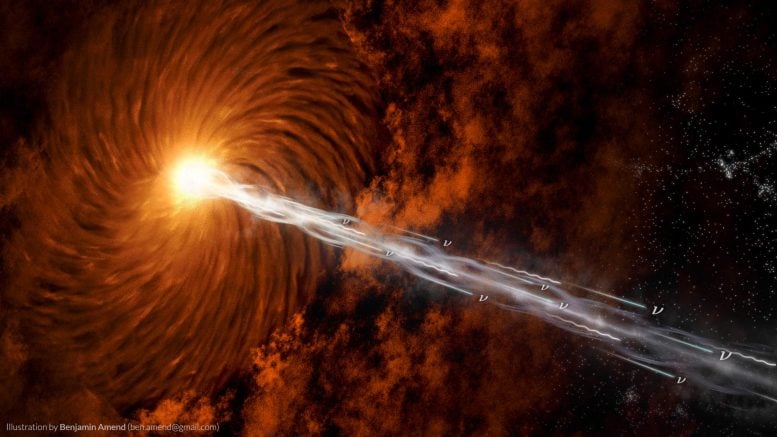
Beginning a Journey Across the Universe: The Discovery of Extragalactic Neutrino Factories. Credit: © Benjamin Amend
For the first time, researchers reveal the origin of neutrinos, elementary particles that reach our planet from the depths of the Universe.
Highly energetic and difficult to detect, neutrinos travel billions of light years before reaching Earth. Although it is known that these elementary particles come from the depths of our Universe, their precise origin is still a mystery. An international research team, led by the University of Würzburg and the University of Geneva (UNIGE), is shedding light on one aspect of this enigma: neutrinos are thought to be born in blazars, galactic nuclei fed by supermassive black holes. These results were published on July 14 in the journal Astrophysical Journal Letters.
Our planet’s atmosphere is continuously bombarded by cosmic rays. These consist of electrically charged particles of extremely high energies — up to 1020 electron volts. For reference, that is a million times more than the energy achieved in the world’s most powerful particle accelerator, CERN’s Large Hadron Collider near Geneva. The incredibly energetic particles come from deep outer space and have traveled billions of light years. Where do they originate, what shoots them through the Universe with such tremendous force? These questions have remained among the greatest challenges of astrophysics for over a century.
Cosmic rays’ birthplaces produce neutrinos. These neutral particles are very difficult to detect. They have almost no mass and barely interact with matter. They race through the Universe and can travel right through galaxies, planets, and the human body almost without a trace. “Astrophysical neutrinos are produced exclusively in processes involving cosmic ray acceleration,” explains astrophysics Professor Sara Buson from Julius-Maximilians-Universität (JMU) Würzburg in Bavaria, Germany. This is precisely what makes these neutrinos unique messengers paving the way to pinpoint cosmic ray sources.
A step forward in a controversial debate
Despite the vast amount of data that astrophysicists have collected, the association of high-energy neutrinos with the astrophysical sources that originate them has remained an unsolved problem for years. Sara Buson has always considered it a major challenge. It was in 2017 that the researcher and collaborators first brought a blazar (TXS 0506+056) into the discussion as a potential neutrino source in the journal Science. Blazars are active galactic nuclei powered by supermassive black holes that emit much more radiation than their entire galaxy. A scientific debate was sparked by the publication about whether there truly is a connection between blazars and high-energy neutrinos.
Following this first encouraging step, in June 2021 Prof. Buson’s group began an ambitious multi-messenger research project with the support of the European Research Council. This involves analyzing various signals (“messengers,” e.g. neutrinos) from the Universe. The main goal is to shed light on the origin of astrophysical neutrinos and possibly establish blazars as the first source of extragalactic high-energy neutrinos with high certainty.
The project is now showing its first success: In the journal Astrophysical Journal Letters, Sara Buson, along with her group, the former postdoctoral researcher Raniere de Menezes (JMU) and Andrea Tramacere from the University of Geneva, reports that blazars can be confidently associated with astrophysical neutrinos at an unprecedented degree of certainty.
Revealing the role of blazars
Andrea Tramacere is one of the experts in numerical modeling of acceleration processes and radiation mechanisms acting in relativistic jets — outflows of accelerated matter, approaching the speed of light — in particular blazar jets. “The accretion process and the rotation of the black hole lead to the formation of relativistic jets, where particles are accelerated and emit radiation up to energies of a thousand billion of that of visible light! The discovery of the connection between these objects and the cosmic rays may be the ‘Rosetta stone’ of high-energy astrophysics!”
To arrive at these results, the research team utilized neutrino data from the IceCube Neutrino Observatory in Antarctica — the most sensitive neutrino detector currently in operation — and BZCat, one of the most accurate catalogues of blazars. “With this data, we had to prove that the blazars whose directional positions coincided with those of the neutrinos were not there by chance.” To do this, the UNIGE researcher developed software capable of estimating how much the distributions of these objects in the sky look the same. “After rolling the dice several times, we discovered that the random association can only exceed that of the real data once in a million trials! This is strong evidence that our associations are correct.”
Despite this success, the research team believes that this first sample of objects is only the ‘tip of the iceberg’. This work has enabled them to gather “new observational evidence”, which is the most important ingredient for building more realistic models of astrophysical accelerators. “What we need to do now is to understand what the main difference is between objects that emit neutrinos and those that do not. This will help us to understand the extent to which the environment and the accelerator ‘talk’ to each other. We will then be able to rule out some models, improve the predictive power of others and, finally, add more pieces to the eternal puzzle of cosmic ray acceleration!”
Reference: “Beginning a Journey Across the Universe: The Discovery of Extragalactic Neutrino Factories” by Sara Buson, Andrea Tramacere, Leonard Pfeiffer, Lenz Oswald, Raniere de Menezes, Alessandra Azzollini and Marco Ajello, 14 July 2022, Astrophysical Journal Letters.
DOI: 10.3847/2041-8213/ac7d5b

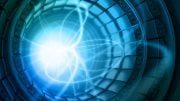

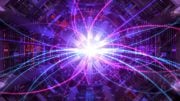
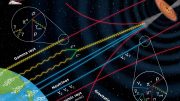
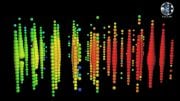
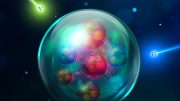


How is the scientific community going to understand where this energy comes from when the most powerful objects in the universe, which are black holes, are forced to not be able to release any energy at all? All types of stars and even planets like Jupiter release radiation but black holes release nothing? It makes no sense at all.
Cosmic and gamma rays are coming from black holes because black holes are not “singularities”, they are just stars. Stars that don’t create the optically visible light we can see but only the invisible radiation like cosmic and gamma rays. Why would they release absolutely nothing? Why would the scientific community allow a theory to claim this?
The reason is the theory picking gravity to create everything. Gravity was forced to be the energy provider of this universe because, what else was going to turn all that initial hydrogen into stars? A blow torch? Gravity was forced to be a “free energy” which is impossible in this universe. That’s why the force of gravity, and these cosmic rays, are unable to be explained.
13.8 billion years ago, our universe didn’t just spring into life. It was all already here. Gravity did not create all the energy we see. A collision did. Our universe turned itself into a particle collider no different than any of the ones here on Earth. The galaxies are shrapnel from the energy of this event. Gravity had not one thing to do with the energy we see. All it did was keep the matter together after it was put into the quark plasma state after the collision. Energy creates gravity, gravity doesn’t create energy.
It is the black holes creating this energy. Why wouldn’t it be? Black holes are absolute minimum entropy matter that is made of nothing but separated quarks and uses the dark matter of space that causes the force of gravity as its endless catalyst. The strong force in our universe exists between quarks and the particles that make up space which I believe are an extremely pressurized field of sterile electron neutrinos. Quarks are the positive matter in our universe and sterile electron neutrinos are the negative matter. Once quarks have been separated from a sufficient enough reaction, it is the sheer density and pressure of space itself that is able to overcome the strong force between these particles and keep the quarks apart indefinitely. As a result of this plasma, the incoming neutrinos of space are ejected from the mass with the strong force as the most powerful electromagnetic radiation in the universe which are gamma and cosmic rays. The pressure of the dark matter of space is the endless catalyst that makes this reaction the most efficient energy in the universe and is also the energy that science is looking for to create the future energy for humans. Fusion is not working and never will because quark plasma is the energy they seek.
The only was science is going to figure out the solutions to all the problems that exist is to realize what happened 13.8 billion years ago. It wasn’t magic, it was an event in an already existing, static universe. Our universe turned itself into a particle collider. That is what Hubble discovered. All the laws are followed. All the questions are answered.